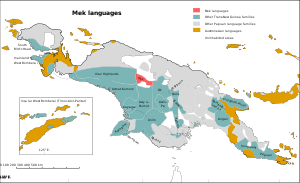Mek languages
The Mek languages are a well established family of Papuan languages spoken by the Mek peoples. They form a branch of the Trans–New Guinea languages (TNG) in the classifications of Stephen Wurm (1975) and of Malcolm Ross (2005).
| Mek | |
|---|---|
| Goliath | |
| Ethnicity | Mek people |
| Geographic distribution | New Guinea |
| Linguistic classification | Trans–New Guinea |
| Glottolog | mekk1240[2] |
 Map: The Mek languages of New Guinea
The Mek languages
Other Trans–New Guinea languages
Other Papuan languages
Austronesian languages
Uninhabited | |
Mek, then called Goliath, was identified by M. Bromley in 1967. It was placed in TNG by Wurm (1975).
Languages
The Mek languages form three dialect chains (Heeschen 1998):
Phonemes
Usher (2020) reconstructs the consonant and vowel inventories as 'perhaps' as follows:[3]
*m *n *ŋ *p *t *k *kʷ *(m)b *(n)d *(ŋ)g *(ŋ)gʷ *s *w *l *j
i u e o ɛ ɔ a ɒ
ei ou ɛi ɔu ai au aɛ aɔ
Pronouns
Pronouns are:[3]
sg pl 1 *na *nu[n] 2 *kan *kun (?) 3 *ɛl *tun, *[t/s]ig
The difference between the two 3pl forms is not known. 2pl and 3pl have parallels in Momuna /kun tun/.
Evolution
Mek reflexes of proto-Trans-New Guinea (pTNG) etyma are:[4]
- mun ‘belly’ < *mundun ‘internal organs’
- kuna ‘shadow’ < *k(a,o)nan
- saŋ ‘dancing song’ < *saŋ
- getane ‘sun’ < *kVtane
- mundo ‘belly’ < *mundun ‘internal organs’
- ami ‘louse’ < *niman
- si ‘tooth’ < *(s,t)i(s,t)i
- tomo < *k(i,u)tuma ‘night’
Yale language:
- de ‘to burn’ < *nj(a,e,i)
- mon ‘belly’ < *mundun ‘internal organs’
- xau ‘ashes’ < *kambu
gollark: What an excellent domain and/or document organization scheme.
gollark: Or 0.
gollark: The easiest thing is multiplication by 1.
gollark: Oh yes, I'll just multiply things by 10^6, I can DEFINITELY do that mentally.
gollark: It turns out that computer algebra is hard.
References
- Momuna–Mek, New Guinea World
- Hammarström, Harald; Forkel, Robert; Haspelmath, Martin, eds. (2017). "Mek". Glottolog 3.0. Jena, Germany: Max Planck Institute for the Science of Human History.
- New Guinea World
- Pawley, Andrew; Hammarström, Harald (2018). "The Trans New Guinea family". In Palmer, Bill (ed.). The Languages and Linguistics of the New Guinea Area: A Comprehensive Guide. The World of Linguistics. 4. Berlin: De Gruyter Mouton. pp. 21–196. ISBN 978-3-11-028642-7.
- Ross, Malcolm (2005). "Pronouns as a preliminary diagnostic for grouping Papuan languages". In Andrew Pawley; Robert Attenborough; Robin Hide; Jack Golson (eds.). Papuan pasts: cultural, linguistic and biological histories of Papuan-speaking peoples. Canberra: Pacific Linguistics. pp. 15–66. ISBN 0858835622. OCLC 67292782.
External links
- Timothy Usher, New Guinea World, Proto–Momuna–Mek
- (ibid.) Proto–Mek
This article is issued from Wikipedia. The text is licensed under Creative Commons - Attribution - Sharealike. Additional terms may apply for the media files.